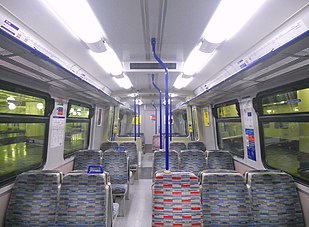
Back بریتیش ریل کلاس ۳۱۵ Persian Class 315 French British Rail 315 sorozat Hungarian イギリス国鉄315形電車 Japanese British Rail Class 315 Polish British Rail Class 315 SIMPLE British Rail Class 315 Ukrainian 英国铁路315型电力动车组 Chinese
| British Rail Class 315 | |
|---|---|
 TfL Rail Class 315 at Forest Gate in September 2015 | |
 The refreshed interior of a TfL Rail Class 315 | |
| In service | 1980 – 9 December 2022 |
| Manufacturer | British Rail Engineering Limited |
| Built at | Holgate Road Works, York |
| Family name | BREL 1972 |
| Replaced | |
| Constructed | 1980–1981 |
| Refurbished |
|
| Number built | 61[2] |
| Number preserved | 1 |
| Number scrapped | 53 |
| Successor | |
| Formation |
|
| Diagram |
|
| Fleet numbers | 315801–315861 |
| Capacity |
|
| Owners | Eversholt Rail Group |
| Operators | |
| Specifications | |
| Car body construction | Steel underframe with aluminium body and roof |
| Car length |
|
| Width | 2.820 m (9 ft 3.0 in) |
| Height | 3.582 m (11 ft 9.0 in) |
| Floor height | 1.156 m (3 ft 9.5 in) |
| Doors | Double-leaf pocket sliding, each 1.288 m (4 ft 2.7 in) wide (2 per side per car) |
| Wheelbase |
|
| Maximum speed | 75 mph (121 km/h) |
| Weight |
|
| Traction motors | |
| Power output | 660 kW (880 hp) |
| Acceleration | 0.75 m/s2 (2.5 ft/s2)[3] |
| HVAC | Ducted warm air |
| Electric system(s) | 25 kV 50 Hz AC overhead |
| Current collector(s) | Pantograph |
| UIC classification | Bo′Bo′+2′2′+2′2′+Bo′Bo′ |
| Bogies | BREL BX1 |
| Minimum turning radius | 70.4 m (231 ft 0 in) |
| Braking system(s) | Electro-pneumatic (disc) |
| Safety system(s) | |
| Coupling system | Tightlock[4] |
| Multiple working | Within class |
| Track gauge | 1,435 mm (4 ft 8+1⁄2 in) standard gauge |
| Notes/references | |
| Specifications as at November 1987[5] except where otherwise noted. | |
The British Rail Class 315 is a fleet of alternating current (AC) electric multiple unit (EMU) trains that were built by British Rail Engineering Limited at Holgate Road Carriage Works in York between 1980 and 1981 to replace the Class 306 units. It was a variant of unit derived from British Rail's 1971 prototype suburban EMU design which, as the BREL 1972 family, eventually encompassed 755 vehicles across Classes 313, 314, 315, 507 and 508.[6] Revenue services with Class 315 units commenced in 1980 and continued until 9 December 2022.[2][7]
- ^ "News Desk" (PDF). The Railway Herald. No. 125. Northallerton. 21 March 2008. p. 4. ISSN 1751-8091. Archived from the original (PDF) on 9 October 2011. Retrieved 15 July 2011.
- ^ a b "PEP-talk: the BR second generation EMU". Rail Express. No. 317. Horncastle: Mortons Media Group. October 2022. pp. 54–55.
- ^ "Class 315". London: Eversholt Rail. Archived from the original on 3 February 2020. Retrieved 3 February 2020.
- ^ System Data for Mechanical and Electrical Coupling of Rail Vehicles in support of GM/RT2190 (PDF). London: Rail Safety and Standards Board. 22 June 2011. p. 4. SD001. Archived from the original (PDF) on 1 April 2012. Retrieved 22 November 2022.
- ^ "Vehicle Diagram Book No. 210 for Electrical Multiple Units (including A.P.T.)" (PDF). Barrowmore MRG. BRB Residuary Ltd. EA207 & EH216–EH217 (in work pp. 16–17 & 286–289). Archived from the original (PDF) on 21 January 2015. Retrieved 21 January 2015.
- ^ "The twilight zone". Railways Illustrated. No. 249. November 2023. pp. 50–53.
- ^ "Class 315 farewell set saved". The Railway Magazine. No. 1462. January 2023. p. 73.